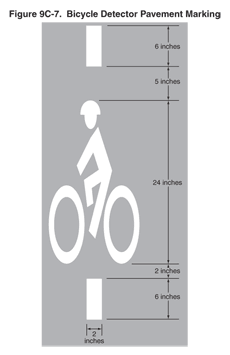When it comes to tripping a traffic signal with your bicycle, many of us get the feeling — “Does anybody know I'm here?”
Those loops in the pavement don't always pick up your bike, especially if it's shy on steel or other metal parts.
Depending on where you live, sometimes pavement markings show where to line up. Placing your front tire on the “T” is supposed to work in , while “X” marks the spot in Bellevue.
Neighboring Redmond, Washington, has produced a video that gives some guidance on how a cyclist can trigger a stop light if there aren't any pavement markings.
Law requires bicycle detection
Since July 2009, Washington state law requires that intersections with traffic sensor devices be able to detect bicycles and motorcycles. Senate Bill 5482 says (on the last couple of pages):
“During routine maintenance or monitoring activities, but subject to the availability of funds:
“All existing vehicle-activated traffic control signals that do not currently routinely and reliably detect motorcycles and bicycles must be adjusted to do so to the extent that the existing equipment is capable consistent with safe traffic control. Priority must be given to existing vehicle-activated traffic control signals for which complains relating to motorcycle or bicycle detection have been received and existing vehicle-activated traffic control signals that are otherwise identified as a detection problem for motorcyclists or bicyclists, or both.
Jurisdictions operating existing vehicle-activated traffic control signals shall establish and publicize a procedure for filing these complaints in write or by e-mail and maintain a record of these complaints and responses.”
New bicycle markings
So if you live in Washington state and you're left hanging at a left turn signal that just doesn't detect your bicycle, remember to contact the local city or county and let someone know. I have an intersection in mind in the city of Newcastle that I plan to contact someone about today.
Adjusting the sensors for bicycles shouldn't be too difficult. Josh Putnam writes that sensors can be adjusted to high sensitivity in order to detect the metal in a bicycle wheel.
Meanwhile, the Manual on Uniform Traffic Control Devices issued updated instructions for bicycle signage along streets and highways. Among them was a bicycle detector pavement marking, seen at left. The marking is 24 inches long and the lines show where to line up your bicycle tires.


Recent Comments